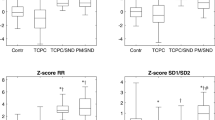Abstract.
Sinus node recovery times have been used to evaluate sinus node function in adults and children. Normal values for corrected sinus node recovery time (CSNRT) are generally accepted as 275 and 500–550 msec in young children and adults, respectively. However, normal CSNRT values have not been determined for adolescent patients. Therefore, we mesured CSNRT in 29 consecutive patients, ages 12–17 years, who underwent electrophysiology testing as part of radiofrequency ablation. CSNRTs were performed by rapid atrial pacing for 30 seconds. Pacing cycle lengths were then shortened in 50-msec decrements to a minimum of 300 msec CSNRTs were determined by subtracting the patients' resting sinus cycle length from the maximal SNRT measured. The mean CSNRT was 323 ± 61 msec (mean ± SD, range 186–422 msec). A significant positive correlation between CSNRT and age was found. We conclude that the CSNRT value for the upper limit of normal in adolescents lies between the normal values previously determined for children and adults and is approximately 445 msec (mean + 2 SD). Because sinus node dysfunction is a well-recognized, long-term complication following surgical repair for complex congenital heart disease, this value becomes especially relevant as more children with congenital heart disease survive into adolescence.
Similar content being viewed by others
Author information
Authors and Affiliations
Rights and permissions
About this article
Cite this article
Samson, R., Jolma, C. & Zamora, R. Normal Values for Corrected Sinus Node Recovery Time in Adolescents. Pediatr Cardiol 20, 396–399 (1999). https://doi.org/10.1007/s002469900499
Published:
Issue Date:
DOI: https://doi.org/10.1007/s002469900499



